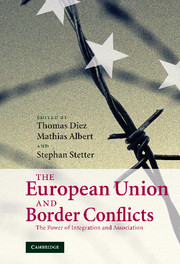Book contents
- Frontmatter
- Contents
- List of tables
- Notes on contributors
- Acknowledgements
- List of abbreviations
- Introduction
- 1 The transformative power of integration: conceptualising border conflicts
- 2 The influence of the EU towards conflict transformation on the island of Ireland
- 3 Catalysis, catachresis: the EU's impact on the Cyprus conflict
- 4 Transforming the Greek–Turkish conflicts: the EU and ‘what we make of it’!
- 5 Border issues in Europe's North
- 6 The EU and the Israel–Palestine conflict
- 7 The EU as a ‘force for good’ in border conflict cases?
- Conclusion
- References
- Index
1 - The transformative power of integration: conceptualising border conflicts
Published online by Cambridge University Press: 22 September 2009
- Frontmatter
- Contents
- List of tables
- Notes on contributors
- Acknowledgements
- List of abbreviations
- Introduction
- 1 The transformative power of integration: conceptualising border conflicts
- 2 The influence of the EU towards conflict transformation on the island of Ireland
- 3 Catalysis, catachresis: the EU's impact on the Cyprus conflict
- 4 Transforming the Greek–Turkish conflicts: the EU and ‘what we make of it’!
- 5 Border issues in Europe's North
- 6 The EU and the Israel–Palestine conflict
- 7 The EU as a ‘force for good’ in border conflict cases?
- Conclusion
- References
- Index
Summary
The puzzle of integration and peace
As we discussed in the Introduction, there has always been a close link between European integration and peace. Reference to the war-torn Europe of the past has become the most consistent, most frequently cited legitimisation of integration. It has provided the EU and its predecessors with a form of identity (Wæver 1998b: 90; see also Wallace 1999 and Diez 2004). It is against this background that the European Union is, therefore, often regarded as a successful example of (border) conflict transformation. The very process of integration is seen as having led to the evolution of a ‘security community’ among former long-time foes. Cross-border cooperation has flourished not only between nation states, but also between local and regional bodies in the context of the Interreg programme, and not only across internal EU boundaries, but also across its external borders.
This largely uncontested success story notwithstanding, the theoretical account of the link between integration and peace marks, at best, a dormant issue within the academic fields of European studies and International Relations, with only a very limited number of exceptions (Noutcheva et al. 2004; Tavares 2004; Tocci 2005a; 2005b). However, such a theoretical account is not only of academic, but also of a highly practical, interest in that it enables the systematic comparison of empirical cases, and allows drawing conclusions for EU policy towards border conflicts within the scope of integration and association, as is the purpose of this volume.
Information
- Type
- Chapter
- Information
- The European Union and Border ConflictsThe Power of Integration and Association, pp. 13 - 32Publisher: Cambridge University PressPrint publication year: 2008
Accessibility standard: Unknown
Why this information is here
This section outlines the accessibility features of this content - including support for screen readers, full keyboard navigation and high-contrast display options. This may not be relevant for you.Accessibility Information
- 7
- Cited by
